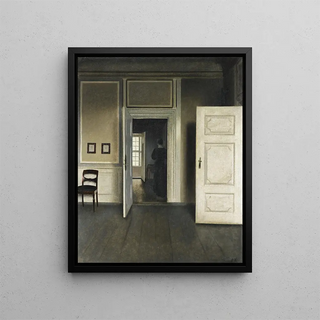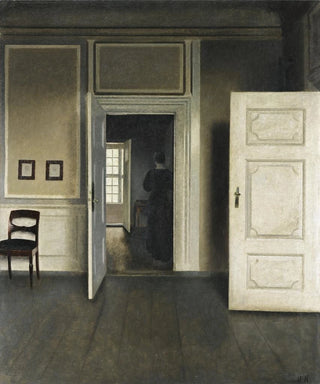Art print | Interior: Strandgade 30 - Vilhelm Hammershøi


View from behind

Frame (optional)
Interior Art print: Strandgade 30 - Vilhelm Hammershøi – Captivating Introduction
In the world of art, some works manage to transcend the simple frame of painting to become true windows into moments frozen in time. "Interior: Strandgade 30" by Vilhelm Hammershøi is one of these masterpieces. This painting, which captures the essence of a Danish interior, invites the viewer to immerse themselves in an atmosphere filled with serenity and mystery. The soft light filtering through the windows, the delicate hues, and the streamlined shapes create a contemplative ambiance, where each element seems to tell a story—one of simple daily life yet rich in emotion. Hammershøi succeeds in evoking a rare intimacy, where the gaze is lost in the details, revealing the beauty of ordinary things.
Style and uniqueness of the work
Hammershøi's work is distinguished by its unique style, characterized by minimalist compositions and a nuanced color palette. In "Interior: Strandgade 30," light plays a central role, subtly illuminating surfaces and creating delicate shadows that add depth to the scene. The pastel-colored walls, the simply designed furniture, and everyday objects are arranged with precision that reflects the artist's keen eye. Every element is carefully chosen, contributing to the harmony of the whole. Hammershøi does not merely aim to depict a space but to evoke an atmosphere, an emotion. Human figures, often present in his works, are absent here, leaving the viewer free to imagine the stories unfolding within this interior. This choice reinforces the idea of gentle solitude, a suspended moment where time seems to stand still.
The artist and his influence
Vilhelm Hammershøi, born in 1864 in Copenhagen, is an artist who left his mark on his era through his innovative approach to painting. Influenced by the Symbolist movement and realism, he developed a style that is uniquely his own, blending sensitivity and introspection. Hammershøi often explored themes of solitude and intimacy, and he

Matte finish

View from behind

Frame (optional)
Interior Art print: Strandgade 30 - Vilhelm Hammershøi – Captivating Introduction
In the world of art, some works manage to transcend the simple frame of painting to become true windows into moments frozen in time. "Interior: Strandgade 30" by Vilhelm Hammershøi is one of these masterpieces. This painting, which captures the essence of a Danish interior, invites the viewer to immerse themselves in an atmosphere filled with serenity and mystery. The soft light filtering through the windows, the delicate hues, and the streamlined shapes create a contemplative ambiance, where each element seems to tell a story—one of simple daily life yet rich in emotion. Hammershøi succeeds in evoking a rare intimacy, where the gaze is lost in the details, revealing the beauty of ordinary things.
Style and uniqueness of the work
Hammershøi's work is distinguished by its unique style, characterized by minimalist compositions and a nuanced color palette. In "Interior: Strandgade 30," light plays a central role, subtly illuminating surfaces and creating delicate shadows that add depth to the scene. The pastel-colored walls, the simply designed furniture, and everyday objects are arranged with precision that reflects the artist's keen eye. Every element is carefully chosen, contributing to the harmony of the whole. Hammershøi does not merely aim to depict a space but to evoke an atmosphere, an emotion. Human figures, often present in his works, are absent here, leaving the viewer free to imagine the stories unfolding within this interior. This choice reinforces the idea of gentle solitude, a suspended moment where time seems to stand still.
The artist and his influence
Vilhelm Hammershøi, born in 1864 in Copenhagen, is an artist who left his mark on his era through his innovative approach to painting. Influenced by the Symbolist movement and realism, he developed a style that is uniquely his own, blending sensitivity and introspection. Hammershøi often explored themes of solitude and intimacy, and he






